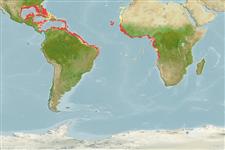Classificação / Names
Common names from other countries
Referência principal
Tamanho / Peso / Idade
Max length : 94.0 cm TL macho/indeterminado; (Ref. 40637); common length : 50.0 cm TL macho/indeterminado; (Ref. 5217); Peso máx. publicado: 8.5 kg (Ref. 40637)
Ambiente
; marinhas associadas(os) a recifes; intervalo de profundidade ? - 650 m (Ref. 3686), usually 50 - 300 m (Ref. 26999)
Clima / Intervalo
Subtropical, preferred 26°C (Ref. 107945); 30°N - 14°S, 98°W - 15°E (Ref. 34024)
Distribuição
Western Atlantic: off the continental coast from Florida, USA and the Gulf of Mexico to northern South America, including islands in the Caribbean. Eastern Atlantic: off Senegal to Angola.
Países | Áreas FAO | Ecossistemas | Ocorrências | Introduções
Descrição breve
Espinhos dorsais (total): 0; Raios dorsais moles (total): 109-117; Espinhos anais 0; Raios anais moles: 86 - 90. Body completely covered with small, imbricate, cycloid scales; barbels present on snout (6) and chin (6); branchiostegal rays 8; median basibranchial tooth patch absent; developed gill rakers on first arch 4 or fewer; pelvic fin rays inserted at about level of preopercle, well behind eye (Ref. 34024). Ventral fins dark, gradually becoming darker at the extreme blackish edge (Ref. 13608).
Categoria na Lista Vermelha da IUCN (Ref. 115185)
Ameaça para o homem
Harmless
Utilização humana
Pescarias: pouco comercial; peixe desportivo: sim
Mais informação
ReferênciasAquaculturaPerfil para aquaculturaEstirpesGenéticaFrequência dos alelosHereditariedadeDoençasProcessamentoMass conversion
Ferramentas
Relatórios especiais
Descarregue XML
Fontes da internet
Estimates of some properties based on models
Phylogenetic diversity index
PD50 = 0.5156 many relatives (e.g. carps) 0.5 - 2.0 few relatives (e.g. lungfishes)
Nível Trófico
3.9 ±0.6 se; Based on size and trophs of closest relatives
Resiliência
Médio, tempo mínimo de duplicação da população 1,4 - 4,4 anos (K=0.19)
Vulnerabilidade
Moderate to high vulnerability (52 of 100)
Categoria de preço
